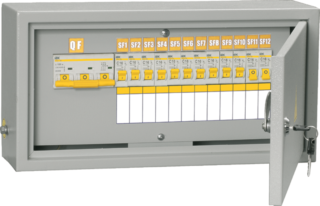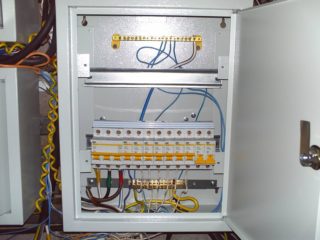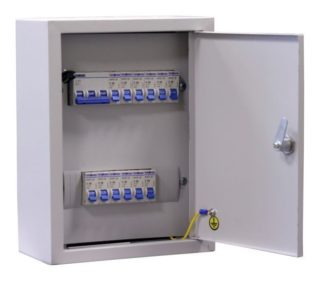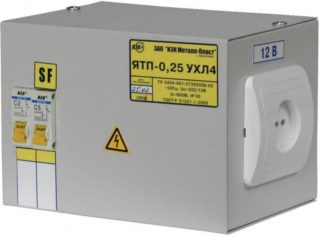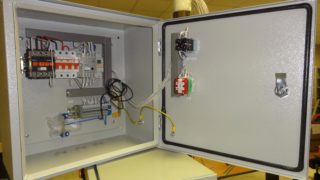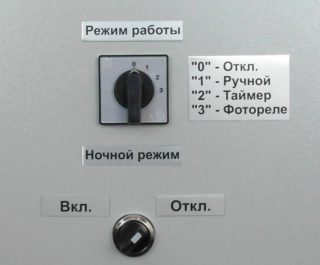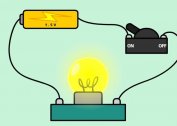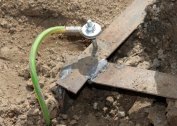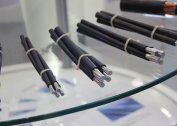Typical lighting panels (OSH) belong to the category of equipment intended exclusively for servicing the supply circuits of 380 Volt lighting systems. Unlike power cabinets, the load in them is strictly regulated and does not exceed the established norm. In addition, they provide for the possibility of changing the operating mode of individual groups of illuminators through the use of built-in switching devices.
OSH classification
Modern electric lighting panels are classified according to a number of signs, the main of which are the body material and the installation method. All OSH models are divided into products made from the following materials:
- metal;
- fireproof plastic.
Metal cases are used in panel constructions, which are supposed to be used outdoors. Therefore, they are reliably protected from external influences and bad weather and have a high IP rating.
To extend the service life, typical outdoor panels are additionally treated with special impregnations and coatings. A high degree of security allows them to be installed at facilities with increased operational danger. Their counterparts from non-combustible plastic have an attractive appearance and are suitable for indoor use.
A distinctive feature of shields of this type is their fire safety, since the plastic used in the manufacture does not burn.
Depending on the installation method, the lighting control panel can have the following versions:
- in the form of a hinged structure;
- wall-mounted product.
Wall mounted enclosures are optimally suited for installation in factory floors and other production facilities. They are hung in a place convenient for placement and fixed on the walls by means of mounting dowels.
Recessed panels installed in the corridors and on the staircases must be equipped with locks, the keys of which are stored by the electrician on duty. Most of them have an attractive design and are installed in places where special attention is paid to aesthetics. In case of violation of the general situation, it is recommended to install them in the niches available in most office rooms.
Construction and equipment
The requirements for the design and electrical circuit of the lighting board are almost the same as for its distribution analogue. Mains power is supplied through a switch designed for the total load of the serviced lighting lines. The cable entry into the light control device is protected by a separate circuit breaker. Purely structurally modern lighting panel is a switchgear with fastening elements placed in it.
For fixing the mounted devices, rails called DIN rails are used.
The following switching equipment is located inside the cabinet:
- automation devices;
- linear machines for protecting outgoing lines;
- opening switch.
In addition, it may contain control and monitoring equipment. Protection of lighting circuits against current leakage by means of an RCD is generally not applicable. Here in the cabinet there are special pads for connecting grounding conductors.
Specifications
It is more convenient to consider the technical parameters of the light control panels using the OSH series as an example, manufactured in accordance with TU3434-006-33874352-2004. The characteristics of products in this category include the following features:
- protection of single-phase group networks from overloads and short-circuit currents, for which they provide single-pole machines;
- the presence of internal lighting;
- permissibility of connecting to the input cable in several ways (using a batch switch or using special power terminals);
- cable line entry through upper or lower holes with removable covers;
- the number of input conductors connected to one clamp usually does not exceed 2 pieces;
- the maximum section of these tires is 50 m2;
- OSh, OShchV and UOShchV guards are designed for operating voltages of 380/220 Volt and have a mass of 13 to 24 kg.
Products of the OSH and OSHV categories are equipped with AE2050, A3161 or A63 series circuit breakers and are hung on the walls. The guards for the same equipment are intended for installation in niches. All products considered have a degree of protection IP20, corresponding to GOST 14254-96.
Guards for portable illuminators
According to PUE 7 (latest edition) for portable lamps used in hazardous areas, it is allowed to apply a supply voltage of no more than 50 volts. To obtain it, potential-lowering transformers are used that convert 220 V network voltage to 12, 24, 36 or 48 Volts.
For maintenance of portable illuminators, prefabricated guards of a special design are produced, which include the following components:
- voltage transformer;
- automatic machine used for input protection;
- automatic machines protecting lines departing to the consumer;
- socket for connecting portable lamps.
In some cabinet models, cable lines to fixed lamps permanently located in one place are diverted from the secondary winding of the transformer through the machine.
According to the PUE, hazardous conditions in which the use of portable lamps is mandatory include work carried out in confined spaces:
- in trenches (when laying cable lines, for example);
- in inspection pits and basements;
- inside tanks and liquid tanks;
- when the producer is in an uncomfortable position;
- if possible contact with elements of grounding devices.
In all these situations, the permissible voltage should not exceed 12 volts.
A step-down transformer can be installed in the switchboard itself, for which it provides for a special box from the YATP series.
Outdoor light shield
Special control panels for outdoor lighting differ from conventional products in the organization of the network, which can be done manually or in automatic mode. The following electronic components are used for automatic load switching:
- motion sensors detecting movement in the illuminated space;
- photo relay, responsive to the level of illumination in the controlled area;
- sound sensors;
- time relays, including the load at the right time.
Some cabinet models use a radio communication channel to control the operation of illuminators in automatic mode. With its help, it is possible to remotely turn on and off the light on the controlled object.
Manual start
This lighting control mode is used in the following cases:
- during routine maintenance or emergency repairs;
- in case of failure of automation systems;
- if necessary, configure and test new equipment.
To switch the system to manual mode, use the special switches installed on the door of the shield or on its side panel.You can perform this switching in one of the following ways:
- transfer to the desired position of the manual control key;
- by means of a special switch mounted on the outside or inside the cabinet;
- using a push-button station (this option is most often used in the factory).
To transfer the dashboard to group lighting control in automatic mode, you will need to perform a reverse switch.
Emergency lighting
Emergency lighting panels belong to autonomous systems with cable circuits connected to them, laid directly from the input device. They are connected through the reserve input system, which assumes the presence of two independent power supplies.
Unlike the operating mode, emergency lighting cannot be turned off manually, as there is no separate switch in the corresponding equipment. This type of control system has only two modes: emergency lighting is constantly on or off automatically by means of magnetic starters and automation controls them.
Shield Placement
Special requirements are presented to the order of placement of lighting panels, associated with the features of their installation.
- Cabinets are installed in areas remote from sewer, gas and water communications by at least one meter.
- The switchboard room must be reliably protected from flooding. If it is not possible to provide such conditions, they should be placed above the expected water level.
- Boards designed for outdoor lighting are mounted at a height of not less than 20 cm from the floor or concrete base.
- If possible, snow drifts such structures are installed on a special elevation (foundation).
If there is measuring and control equipment in the cabinet, it must be heated. The exception is panel structures equipped with devices operating at temperatures below 5 degrees.
